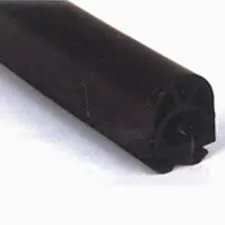Utilizing the Right Seal Material
កក្កដា . 05, 2024 17:38 Back to list
Utilizing the Right Seal Material
Utilizing the Right Seal Material
Selecting the best elastomer for an application involves answering some questions. Temperature and other environmental factors can affect the long-term physical properties of a compound. Therefore, unless a particular application already exists, gathering information on which to base a decision can sometimes be a difficult process.
The following checklist provides several characteristics that need to be taken into consideration when specifying an elastomeric compound. It’s important to know which physical, mechanical, and chemical resistance properties are required. It’s also important that a material is compounded and tested to meet any necessary industrial specifications such as UL, ASTM, SAE, NSF International and U.S. Military Standards, as well as FDA requirements for food-grade gasket materials and antimicrobial materials.
| Physical Properties | Resistance Properties | Mechanical Properties |
|---|---|---|
|
|
|
neoprene rubber gasket with customized size and color sealing water and rubber flange gasket
Types of Rubber Seal Material
Below are brief summaries of the properties of eight of the most versatile polymers. This information is not all-inclusive; however, a majority of sealing, gasketing and weather stripping needs can be met by using these popular materials.
Silicone
Silicone (Polysiloxane) features excellent resistance to ozone, sunlight and oxidation and is very color stable. It also maintains excellent flexibility at low temperatures, has outstanding resistance to high heat, a low compression set and is a very good electrical insulator; however, it is not recommended for applications that require abrasion resistance, tear and cut growth resistance and high tensile strength, nor is it recommended for resistance to oil, gasoline, solvents, alkalis, and acids.
EPDM
EPDM (Ethylene-Propyline-Diene-Monomer) is well known for its excellent ozone, weathering and aging resistance. It also has excellent water and stream resistance, maintains its flexibility at low temperatures, features excellent resistance to alkalis, acids and oxygenated solvents, and is very color stable. It is not recommended for resistance to oil, gasoline and hydrocarbon solvents. EPDM is found in a wide range of applications and is excellent for outdoor use.
Neoprene
Neoprene (Polychloroprene) has moderate resistance to oils and gasoline. It features good flame resistance, weathers well and has very good resistance to abrasion, flex cracking, alkalis and acids. However, expect poor resistance to aromatic and oxygenated solvents and limited flexibility at low temperatures. Neoprene is generally considered an excellent all-purpose elastomer with a solid balance of properties and few limitations.
Nitrile
Nitrile (Acrylonitrile-butadiene) has very good oil and abrasion resistance to alkalis and acids increases as the nitrile content of the compound increases. Nitrile must be specially compounded for resistance to ozone, sunlight and natural aging. It has poor resistance to oxygenated solvents. Nitrile is superior to neoprene in oil and solvent resistance but is not recommended for applications where it is exposed to severe weathering.
PVC Nitrile
PVC Nitrile provides premium performance and long-term reliability in very harsh and corrosive environments. Their exceptional resistance to heat aging and a broad range of fuels, solvents and chemicals makes them ideal for many demanding aerospace, automotive and industrial applications. Fluoroelastomers also offer excellent resistance to weather, ozone, oxygen and sunlight and are inherently more flame retardant than hydrocarbon rubbers. Fluoroelastomers have poor resistance to ketones, ester, ethers, amines and aqueous bases (e.g., ammonia and sodium hydroxide).
Thermoplastic Elastomers (TPE)
TPE are materials that have the properties and performance of rubber but are processed like thermoplastics. Their performance properties are similar to conventional thermosets such as EPDM or neoprene. The important features of TPE are that they are flame resistant and possess resistance to aliphatic and aromatic hydrocarbon solvents, as well as oil and gasoline.
PVC
PVC has excellent impact strength, good resilience, tensile strength, abrasion resistance and maintains flexibility at lower temperatures. It is not the polymer of choice when resistance to oil, gasoline and hydrocarbon solvents is required.
Polycarbonate
Polycarbonate is naturally transparent, with the ability to transmit light nearly that of glass. It has high strength, toughness, heat resistance, and excellent dimensional and color stability. Flame retardants can be added to polycarbonate without significant loss of properties. It has only fair chemical resistance and is attacked by many organic solvents. It is also expensive compared to other plastics.
-
High-Performance Oil Filter H F123 Kawasaki KL250-KLX650 | Engine Protection
NewsAug.05,2025
-
Replacement Filter Screen for Karcher SE3001 SE2001 Vacuum
NewsAug.04,2025
-
Karcher A2004 Vacuum Cartridge Filter Replacement - Durable & Efficient
NewsAug.03,2025
-
Karcher WD/MV HEPA Cartridge Filters | Dust Control Experts
NewsAug.02,2025
-
Top Window Seal Strip Adhesive Companies | Strong Weatherproofing
NewsAug.01,2025
-
Premium Oil Filter for Can-Am Outlander 2003-2017 420256188
NewsJul.31,2025

